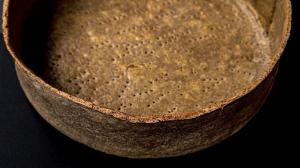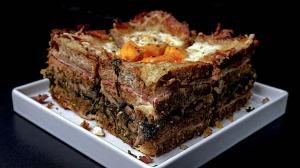It’s going to be a DOUBLE RECIPE POST weekend, divided into 2 PARTS: PART 1 is for the PIE CRUST (or the exterior casing of a huge and high and deep-dish quiche, that could feed 6-8 people) and PART 2 is all about the FILLINGS that go inside that deep-dish quiche but in a new way, with less eggs and cream and cheeses by incorporating a béchamel into the fillings, making it lighter & airier & almost frothier than usual and healthier and if I daresay much more satisfying & tasty, because the balance is just right for appreciating and tasting all the combined flavors and textures.
There’s no mystery to making a dough for a crust. If it’s a flaky puff pastry, it’s got more butter, if it’s a shortcrust pastry, it has half as much butter and more water and egg and if it’s a sweet version for a sweetcrust pastry, then sugar is added too.
But it’s all about the pre-shaping and what size and shape you’re aiming for. Flatter is easier, no matter how wide, but high and deep is another story. It’s hard to drape the dough inside to shape it so you’ll need to do some geometry and math and cutting by creating a cylinder, with one round disk on the bottom and a longer rectangular wide strip that you’ll shape and assemble to make the edges meet up, creating an empty drum or vessel. Of course, you could go further and create a top and seal it all in like a pot-pie but that will be for next time !
If you modify or replace the flour(s), then more or less water may be needed to hold the dough together and yet be easily flattened and shaped.
Blind-baking is a "must" and sealing it with beaten egg that is brushed on the inside will guarantee a crispy and sturdy crust that won’t get soaked, no matter how liquid or wet the fillings are.
You can make the recipe for 1 huge quiche but you could also make 2 average and flatter quiches with the same amounts or 2 smaller deep-dish quiches, depending on what size spring-forms you have handy or even 6-8 mini individual ones if you can muster up the courage.
Anyways, after posting both recipes, I’ll be heading back to bed after a long and pleasant work week but especially since I hardly got any sleep because my ever so quiet, serious, timid, young neighbor decided to have his first party in a year since he moved in, and of course, I wasn’t going to be a party-pooper so I just let him have his fun until 4 am and will just nap today to catch up on my beauty sleep.
Maybe we should all HAVE A NAP today ?! . . . :)


















